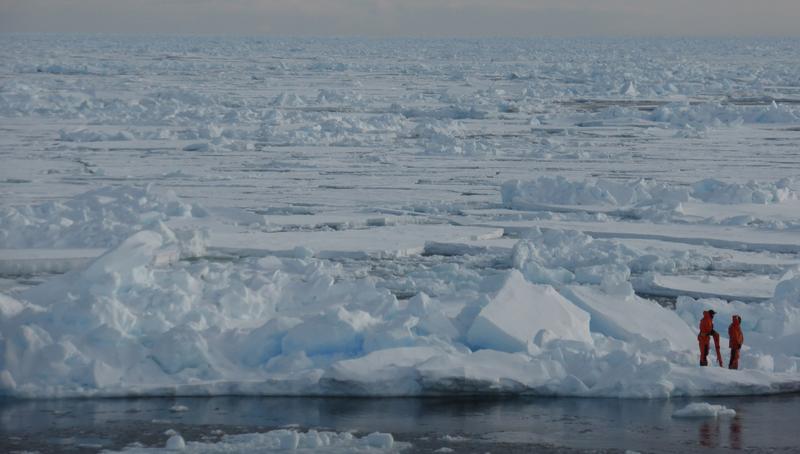

Researchers exploring Arctic sea ice
Photo: Dr. Dirk Notz
These numbers allow one for the first time to grasp the individual contribution to global climate change. The study also explains why climate models usually simulate a lower sensitivity – and concludes that the 2 °C global warming target will not allow Arctic summer sea ice to survive.
The rapid retreat of Arctic sea ice is one of the most direct indicators of the ongoing climate change on our planet. Over the past forty years, the ice cover in summer has shrunk by more than half, with climate model simulations predicting that the remaining half might be gone by mid century unless greenhouse gas emissions are reduced rapidly.
However, a number of studies have indicated that climate models underestimate the loss of Arctic sea ice, which is why the models might not be the most suitable tools to quantify the future evolution of the ice cover.
To address this issue, a new study in the journal Science now derives the future evolution of Arctic summer sea ice directly from the observational record. To do so, the authors examine the link between carbon-dioxide emissions and the area of Arctic summer sea ice, and find that both are linearly related. “The observed numbers are very simple”, explains lead author Dirk Notz.
“For each ton of carbon dioxide that a person emits anywhere on this planet, 3 m² of Arctic summer sea ice disappear.” And his co-author Julienne Stroeve from adds: “So far, climate change has often felt like a rather abstract notion. Our results allow us to overcome this perception. For example, it is now straight-forward to calculate that the carbon dioxide emissions for each seat on a return flight from, say, London to San Francisco causes about 5 m² of Arctic sea ice to disappear.”
The study also explains the linear relationship between carbon-dioxide emissions and sea-ice loss. “Put simply, for each ton of carbon dioxide emission, the climate warms a little bit. To compensate for this warming, the sea-ice edge moves northward to a region with less incoming solar radiation. This then causes the sea-ice area to shrink. Simple geometric reasons cause these processes to combine to the observed linearity ”, explains Notz.
Climate models also simulate the observed linear relationship between sea-ice area and CO₂ emissions. However, they usually have a much lower sensitivity of the ice cover than has been observed. The Science study finds that this is most likely because the models underestimate the atmospheric warming in the Arctic that is induced by a given carbon-dioxide emission. “It seems that it's not primarily the sea-ice models that are responsible for the mismatch. The ice just melts too slow in the models because their Arctic warming is too weak”, says Stroeve.
Regarding the future evolution of Arctic sea ice, the new study finds that the internationally agreed 2 °C global warming target is not sufficient to allow Arctic summer sea ice to survive. Given the observed sensitivity of the ice cover, the sea ice is gone throughout September once another 1000 gigatons of carbon dioxide have been emitted. This amount of emissions is usually taken as a rough estimate of the allowable emissions to reach the 2 °C global-warming target. Only for the much lower emissions that would allow one to keep global warming below 1.5 °C, as called for by the Paris agreement, Arctic summer sea ice has a realistic chance of long-term survival, the study concludes.
Original publication:
Notz, D., and J. Stroeve (2016) Observed Arctic sea-ice loss directly follows anthropogenic CO₂ emission. Science, available online. doi: 10.1126/science.aag2345.
Contact:
Dr. Dirk Notz
Max Planck Institute for Meteorology
Phone: +49 (0) 40 41173 163
Email: dirk.notz@mpimet.mpg.de












